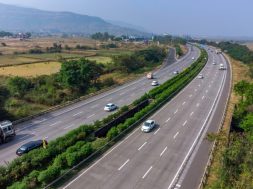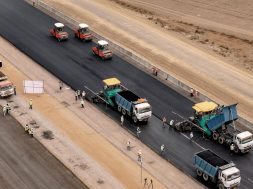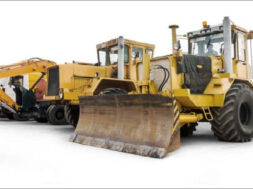The introduction of the EU-Exhaust Emission Regulation Stage III B poses a challenge for the construction machinery manufacturers. The expense is enormous. A great deal of investment and development capacity is necessary. For the buyers that means higher prices, in some cases greater efficiency on the building site. VDMA sees tighter regulation as ‘counter-productive’.
At the Wirtgen-Group, the world’s largest manufacturer of road construction machinery, a major restructuring process is currently underway. In those areas where previously one new roller or milling machine left the conveyor belt, today it is now at least two. “We have a production programme that has practically doubled”, says Dr. Günter Hähn. The unit figures have halved and expenditure almost doubled. “We have to adapt our machines. That costs a lot of money.” What the Executive Director in charge of Wirtgen GmbH’s Technical Division is referring to are the effects of the exhaust emission regulations, which have been in force in Europe and the USA since beginning of this year. Hähn estimates that approximately one third up to half of all development capacities within the group have been taken up by this theme for many months and this will continue to be the case for an indefinite period. The expenditure and costs are enormous.
Similar to Wirtgen, the situation is practically the same for all manufacturers of construction and building material machinery not only in Germany, but throughout Europe and also in the USA. Since the start of this year mobile new machines in the over 130 kW and less than 560 kW categories, which are sold in the USA or Europe, must conform to exhaust emission regulation Stage III B and US norm tier 4 Interim respectively. From 1 January 2012 this will then also apply to the performance classes between 57 and 130 kW and one year later the smaller machines ranging from 37 to 56 kW will be affected. For the manufacturers this means considerable expenditure. Exemption clauses have little or no effect on this.
Machine design completely changedThomas Weber, Managing Director at Volvo Construction Equipment Germany GmbH says, “We have had to completely change the design of our large wheel loaders”. In order to comply with the threshold values for particle and nitric dioxide emissions, Volvo, like many other suppliers, also works with a combination of cooled exhaust recirculation and particle filter. As is also the case in the use of SCR technologies for the reduction of nitric dioxide emissions, in order to fit these systems into the engine compartment, additional space must be created. And this can only be achieved by changing large sections of the design. According to Weber, the development costs are very high in this area. What the Volvo-Manager, similar to Wirtgen Executive Director Hähn, would like to see is a “realistic comparison of costs and benefit and the resulting practically-orientated solutions”. The relation must be right he said. Weber points out that of the products which are also supplied by Volvo, each year a total of only around 30,000 new vehicles come on to the German market. Compared to the registrations of new cars and vans, this represents an extremely small figure. He also said that the total pollution level accounted for by construction machinery was correspondingly low.
In 1998 when the Europe-wide introduction of exhaust emission regulation Stage I began, in most cases relatively small modifications, mainly to the engine, were sufficient to comply with the legal requirements. It was a similar situation, even given the growing requirements placed particularly on the engine manufacturers, with Stage II and III A. “Previously the machines did not change with the introduction of new exhaust emission regulations”, explains Udo Heukrodt, who is in charge of worldwide road-building machinery operations at ABG Allgemeine Baumaschinen-Gesellschaft mbH, part of the Volvo Construction Equipment Group. However, the situation with Stage III B looks completely different. “We need a totally different and larger construction area.” The machines became longer and had a different frame. “In principle they are completely new machines”, said Heukrodt. And their development is costing a great deal of money. “We are trying to keep the effects for the buyers as low as possible. Price increases are however unavoidable”, he said. Heukrodt also adds, “The customers know what they are faced with.”
Global players particularly affectedIn particular producers such as Wirtgen, who sell their products not only in Europe and the USA, but also in other countries, are especially hard-hit by the new exhaust emission regulation. Because the provisions do not apply in those countries, there is no low-sulphur diesel fuel to power these machines, and of course as no one is prepared to pay the higher prices, they must now build two variations of the same machines at their plants, one for the European and US market and the other for the rest of the world. The fact that this results in further considerable added costs, is obvious says Joachim Schmid, who represents the interests of the German construction machinery and construction materials machinery manufacturers as Managing Director within the German Engineering Federation (Verband Deutscher Maschinen- und Anlagenbau – VDMA). He said that the industry had taken considerable burdens upon itself and, as a result, had made its contribution to protecting the environment. However, the emissions do not stop simply at the threshold values. The aim is therefore, increasingly, to also integrate other nations in the legislation. In addition, Schmid points out that a considerable part of the machines are coming onto the market in extremely small unit numbers. He said that he had always doubted whether the expenditure, measured against the benefit in these cases, is always worthwhile.
What also represents another burden for many companies is the situation among the engine manufacturers. Although they have already adapted the machines in the market at the beginning of this year, this was, as Wirtgen Executive Managing Director Hähn assures, “not the case for nearly all the producers concerned”. The background is the large number of different engine variations, which exist in construction and building material machinery. In order to fit in the planned construction space, they must be especially coordinated with practically every model. And this is exactly where the dilemma lies. “Most manufacturers cannot supply us yet with the required machines in the respective installation variations”, says Hähn. In such cases the companies concerned have no other alternative but to make use of the flexibility regulation. Accordingly, they are allowed to put a limited number of machines, which correspond to the previous exhaust emission regulation, on the market until the introduction of a new exhaust regulation stage. For Hähn this does not mean however that the problems have been solved yet. He is calling for improved cooperation with the engine manufacturers to ensure that such delays are avoided in future.
Stage IV applies from 2014With the introduction of Stage III B, the theme of exhaust emission legislation is however still far from over for the construction machinery and building material machinery industry. As early as 2014, Stage IV is set to once again apply on a time-staggered basis according to engine performance classification. Benedict Dunkelberg, Managing Director of Ahlmann Baumaschinen GmbH, part of the Mecalac Group, said that the changes necessary for this are however not so significant and so expensive as those for Stage III B. The manager believes that it is quite possible that several companies could make full use of the flexibility regulation and subsequently immediately put machines on to the market, which comply with the requirements of Stage IV. Dunkelberg comments, “We will master the challenges and offer our customers a sensible product.” Just like practically all the other construction machinery manufacturers, the Executive Director is advocating as much flexibility as possible in the implementation of the new standards. The companies must have sufficient time at their disposal for the introduction of the machines, he said.
While the manufacturers have still got their hands full with refitting and upgrading their machines to Stage III B, in Brussels discussions about a Stage V are already underway. Whether it will come and when and for how long Stage IV will ultimately stay in force as a result, neither the responsible officials nor the politicians can say. According to Frank Diedrich in Brussels, who represents the interests of the construction and also the agricultural machine manufacturers affected by the regulation within the VDMA, the engine manufacturers are calling for a period of at least five years. Just how long it will really be however, no one knows today. Diedrich said, “That was also the case with the previous regulations.” The European construction and agricultural machine manufacturers are also clearly rejecting the introduction of further exhaust emission regulations. VDMA Executive Director Schmid claims, “The industry regards a further tightening of legislation as counter-productive either in terms of environmental policy or economic aspects.
Cookie Consent
We use cookies to personalize your experience. By continuing to visit this website you agree to our Terms & Conditions, Privacy Policy and Cookie Policy.









